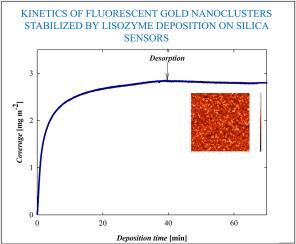溶菌酶稳定的荧光纳米金簇:在二氧化硅基底上的合成与沉积动力学
IF 3.3
3区 物理与天体物理
Q2 OPTICS
引用次数: 0
摘要
通过三水氯化金(III)和溶菌酶(LYZ)分子的化学还原过程,在碱性条件下有效合成了纳米金簇悬浮液。经高分辨率透射电子显微镜(HR-TEM)测定,其尺寸为 1.9 ± 0.5 nm。这种被称为 LYZ-Au NCs 的纳米团簇在 pH 值低于 4 和高于 8 时都很稳定,其水动力直径在 8 到 11 nm 之间。LYZ-Au NCs 的等电点出现在 pH 值 5.0 时。悬浮液显示出明显的荧光,其特征是在 668 纳米波长处有红色发射带。使用石英晶体微天平(QCM)研究了 LYZ-Au NCs 在裸硅传感器和聚(二烯丙基二甲基氯化铵) (PDADMAC) 改性硅传感器上的沉积动力学和稳定性。确定了离子强度、pH 值和悬浮液浓度对 LYZ-Au NCs 沉积动力学的影响。随着离子强度的增加,LYZ-Au NCs 的最大覆盖率明显增加,这是因为沉积团簇之间的静电相互作用范围减小了。原子力显微镜(AFM)证实,在 pH 值为 3.5 的裸硅石和 PDADMAC 改性硅石上形成了覆盖率可控的均匀 LYZ-Au NCs 层。共聚焦显微镜研究表明,这些层还具有明显的荧光特性。本文章由计算机程序翻译,如有差异,请以英文原文为准。

Fluorescent gold nanoclusters stabilized by lysozyme: Synthesis and deposition kinetics on silica substrates
Gold nanoclusters suspension were effectively synthesized under alkaline conditions in a chemical reduction process involving gold(III) chloride trihydrate and lysozyme (LYZ) molecules. Their size determined by high-resolution transmission electron microscopy (HR-TEM) was equal to 1.9 ± 0.5 nm. The nanoclusters, referred to as LYZ-Au NCs, were stable at pH below 4 and above 8, exhibiting a hydrodynamic diameter between 8 and 11 nm. The isoelectric point of LYZ-Au NCs appeared at pH 5.0. The suspension showed a pronounced fluorescence characterized by the red-emitting band at 668 nm. The deposition kinetics and stability of LYZ-Au NCs on bare and poly(diallyldimethylammonium chloride) (PDADMAC)-modified silica sensors were studied using quartz crystal microbalance (QCM). The influence of ionic strength, pH, and suspension concentration on the kinetics of LYZ-Au NCs deposition was determined. The significant increase in the maximum coverage of LYZ-Au NCs with ionic strength was attributed to the decreasing range of electrostatic interactions between deposited clusters. Atomic force microscopy (AFM) confirmed the formation of homogeneous layers of LYZ-Au NCs with controlled coverage on bare silica at pH 3.5 and PDADMAC-modified silica. It was shown by confocal microscopy investigations, that these layers also exhibited pronounced fluorescent properties.
求助全文
通过发布文献求助,成功后即可免费获取论文全文。
去求助
来源期刊

Journal of Luminescence
物理-光学
CiteScore
6.70
自引率
13.90%
发文量
850
审稿时长
3.8 months
期刊介绍:
The purpose of the Journal of Luminescence is to provide a means of communication between scientists in different disciplines who share a common interest in the electronic excited states of molecular, ionic and covalent systems, whether crystalline, amorphous, or liquid.
We invite original papers and reviews on such subjects as: exciton and polariton dynamics, dynamics of localized excited states, energy and charge transport in ordered and disordered systems, radiative and non-radiative recombination, relaxation processes, vibronic interactions in electronic excited states, photochemistry in condensed systems, excited state resonance, double resonance, spin dynamics, selective excitation spectroscopy, hole burning, coherent processes in excited states, (e.g. coherent optical transients, photon echoes, transient gratings), multiphoton processes, optical bistability, photochromism, and new techniques for the study of excited states. This list is not intended to be exhaustive. Papers in the traditional areas of optical spectroscopy (absorption, MCD, luminescence, Raman scattering) are welcome. Papers on applications (phosphors, scintillators, electro- and cathodo-luminescence, radiography, bioimaging, solar energy, energy conversion, etc.) are also welcome if they present results of scientific, rather than only technological interest. However, papers containing purely theoretical results, not related to phenomena in the excited states, as well as papers using luminescence spectroscopy to perform routine analytical chemistry or biochemistry procedures, are outside the scope of the journal. Some exceptions will be possible at the discretion of the editors.
 求助内容:
求助内容: 应助结果提醒方式:
应助结果提醒方式:


